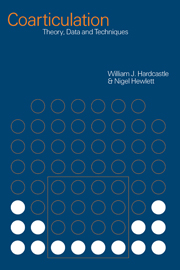Introduction
Published online by Cambridge University Press: 22 September 2009
Summary
Continuous speech is characterized by great variability in the articulatory and acoustic properties of segments. Sound segments are highly sensitive to context and show considerable influence from neighbouring segments. Such contextual effects are described as being the result of overlapping articulation or coarticulation. Coarticulation has been the object of much recent research in speech science and related disciplines.
Coarticulation was the focus of a large-scale research project ACCOR (‘Articulatory–acoustic correlations in coarticulatory processes: a cross-language investigation’) funded by the EU under the ESPRIT framework. ACCOR ran from 1992–1995 and brought together researchers from different parts of Europe in a unique concerted attempt to tackle the problem of coarticulation from a number of different theoretical perspectives and using a variety of different research methodologies. A cross-language approach was used to differentiate between those aspects of the phenomenon which could be attributed to universal features (due to factors such as inherent characteristics of the speech producing mechanism) and those which are language-specific and which could therefore be related to the phonological rules of the particular language.
The project aimed at a detailed description of the complex coordination between the main phonological systems underlying speech production and the resulting acoustic output.
- Type
- Chapter
- Information
- CoarticulationTheory, Data and Techniques, pp. 1 - 4Publisher: Cambridge University PressPrint publication year: 1999

